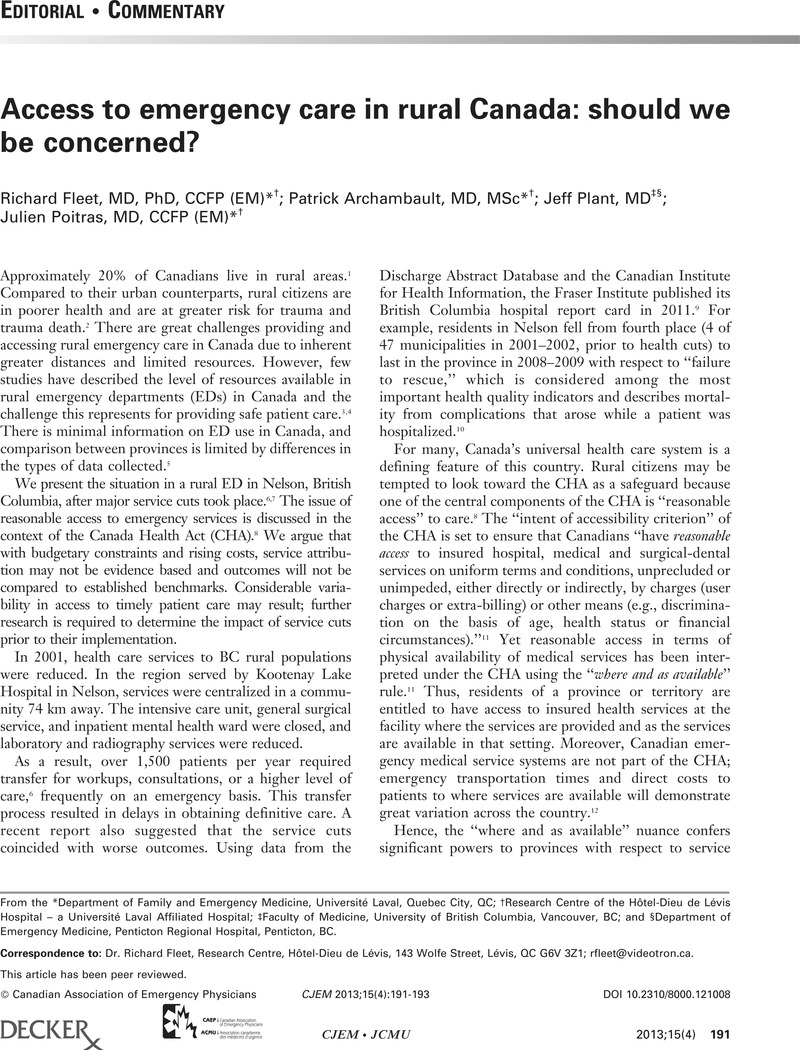Crossref Citations
This article has been cited by the following publications. This list is generated based on data provided by Crossref.
Fleet, Richard
Poitras, Julien
Maltais-Giguère, Julie
Villa, Julie
and
Archambault, Patrick
2013.
A descriptive study of access to services in a random sample of Canadian rural emergency departments.
BMJ Open,
Vol. 3,
Issue. 11,
p.
e003876.
Fleet, Richard
Poitras, Julien
Archambault, Patrick
Tounkara, Fatoumata Korika
Chauny, Jean-Marc
Ouimet, Mathieu
Gauthier, Josée
Dupuis, Gilles
Tanguay, Alain
Lévesque, Jean-Frédéric
Simard-Racine, Geneviève
Haggerty, Jeannie
and
Légaré, France
2015.
Portrait of rural emergency departments in Québec and utilization of the provincial emergency department management Guide: cross sectional survey.
BMC Health Services Research,
Vol. 15,
Issue. 1,
Archambault, Patrick M
Turgeon, Alexis F
Witteman, Holly O
Lauzier, François
Moore, Lynne
Lamontagne, François
Horsley, Tanya
Gagnon, Marie-Pierre
Droit, Arnaud
Weiss, Matthew
Tremblay, Sébastien
Lachaine, Jean
Le Sage, Natalie
Émond, Marcel
Berthelot, Simon
Plaisance, Ariane
Lapointe, Jean
Razek, Tarek
van de Belt, Tom H
Brand, Kevin
Bérubé, Mélanie
Clément, Julien
Grajales III, Francisco Jose
Eysenbach, Gunther
Kuziemsky, Craig
Friedman, Debbie
Lang, Eddy
Muscedere, John
Rizoli, Sandro
Roberts, Derek J
Scales, Damon C
Sinuff, Tasnim
Stelfox, Henry T
Gagnon, Isabelle
Chabot, Christian
Grenier, Richard
and
Légaré, France
2015.
Implementation and Evaluation of a Wiki Involving Multiple Stakeholders Including Patients in the Promotion of Best Practices in Trauma Care: The WikiTrauma Interrupted Time Series Protocol.
JMIR Research Protocols,
Vol. 4,
Issue. 1,
p.
e21.
Fleet, Richard
Pelletier, Christina
Marcoux, Jérémie
Maltais-Giguère, Julie
Archambault, Patrick
Audette, Louis David
Plant, Jeff
Bégin, François
Tounkara, Fatoumata Korika
and
Poitras, Julien
2015.
Differences in Access to Services in Rural Emergency Departments of Quebec and Ontario.
PLOS ONE,
Vol. 10,
Issue. 4,
p.
e0123746.
Rechel, Bernd
Džakula, Aleksandar
Duran, Antonio
Fattore, Giovanni
Edwards, Nigel
Grignon, Michel
Haas, Marion
Habicht, Triin
Marchildon, Gregory P.
Moreno, Antonio
Ricciardi, Walter
Vaughan, Louella
and
Smith, Tina Anderson
2016.
Hospitals in rural or remote areas: An exploratory review of policies in 8 high-income countries.
Health Policy,
Vol. 120,
Issue. 7,
p.
758.
Caxaj, C. Susana
2016.
A Review of Mental Health Approaches for Rural Communities: Complexities and Opportunities in the Canadian Context.
Canadian Journal of Community Mental Health,
Vol. 35,
Issue. 1,
p.
29.
Slaunwhite, Amanda K.
and
Macdonald, Scott
2016.
Regional Variations in General Practitioner Visits for Alcohol-Attributed Diseases in British Columbia, Canada.
International Journal of Mental Health and Addiction,
Vol. 14,
Issue. 6,
p.
952.
Layani, Géraldine
Fleet, Richard
Dallaire, Renée
Tounkara, Fatoumata K.
Poitras, Julien
Archambault, Patrick
Chauny, Jean-Marc
Ouimet, Mathieu
Gauthier, Josée
Dupuis, Gilles
Tanguay, Alain
Lévesque, Jean-Frédéric
Simard-Racine, Geneviève
Haggerty, Jeannie
and
Légaré, France
2016.
The challenges of measuring quality-of-care indicators in rural emergency departments: a cross-sectional descriptive study.
CMAJ Open,
Vol. 4,
Issue. 3,
p.
E398.
Micks, Taft
Sue, Kyle
and
Rogers, Peter
2016.
Barriers to point-of-care ultrasound use in rural emergency departments.
CJEM,
Vol. 18,
Issue. 6,
p.
475.
Keys, Jennifer
Venter, Louise
and
Nixon, Garry
2017.
The use of CT in the management of minor head injuries in Queenstown.
Journal of Primary Health Care,
Vol. 9,
Issue. 2,
p.
162.
Fleet, Richard
Dupuis, Gilles
Fortin, Jean-Paul
Gravel, Jocelyn
Ouimet, Mathieu
Poitras, Julien
and
Légaré, France
2017.
Rural emergency care 360°: mobilising healthcare professionals, decision-makers, patients and citizens to improve rural emergency care in the province of Quebec, Canada: a qualitative study protocol.
BMJ Open,
Vol. 7,
Issue. 8,
p.
e016039.
Panagiotoglou, Dimitra
Law, Michael R.
and
McGrail, Kimberlyn
2017.
Effect of Hospital Closures on Acute Care Outcomes in British Columbia, Canada.
Medical Care,
Vol. 55,
Issue. 1,
p.
50.
Fleet, Richard
Hegg-Deloye, Sandrine
Maltais-Giguère, Julie
Légaré, France
Ouimet, Mathieu
Poitras, Julien
Tanguay, Alain
Archambault, Patrick
Levesque, Jean-Frédéric
Simard–Racine, Geneviève
and
Dupuis, Gilles
2019.
The Quebec emergency department guide: A cross-sectional study to evaluate its use, perceived usefulness, and implementation in rural emergency departments.
CJEM,
Vol. 21,
Issue. 1,
p.
103.
McDonnell, Leah
Lavoie, Josée G.
Healey, Gwen
Wong, Sabrina
Goulet, Sara
and
Clark, Wayne
2019.
Non-clinical determinants of Medevacs in Nunavut: perspectives from northern health service providers and decision-makers.
International Journal of Circumpolar Health,
Vol. 78,
Issue. 1,
p.
1571384.
Haase, Kristen R.
Gifford, Wendy
Holtslander, Lorraine
and
Thomas, Roanne
2019.
Managing Cancer Experiences.
Cancer Nursing,
Vol. 42,
Issue. 5,
p.
E53.
Chouinard, Audrey
Charpentier, Danielle
Doucet, Stéphane
Messier, Christine
and
Vachon, Marie-France
2020.
From theory to practice: implementing a standardized, interactive education session on oral anticancer medication (OAM) for patients and their caregivers.
Supportive Care in Cancer,
Vol. 28,
Issue. 8,
p.
3897.
Fleet, Richard
Turgeon-Pelchat, Catherine
Smithman, Mélanie Ann
Alami, Hassane
Fortin, Jean-Paul
Poitras, Julien
Ouellet, Jean
Gravel, Jocelyn
Renaud, Marie-Pierre
Dupuis, Gilles
and
Légaré, France
2020.
Improving delivery of care in rural emergency departments: a qualitative pilot study mobilizing health professionals, decision-makers and citizens in Baie-Saint-Paul and the Magdalen Islands, Québec, Canada.
BMC Health Services Research,
Vol. 20,
Issue. 1,
Brannan, V.
Dunne, C. L.
Dubrowski, A.
and
Parsons, M. H.
2021.
Development of a novel 3D-printed multifunctional thorax model simulator for the simulation-based training of tube thoracostomy.
Canadian Journal of Emergency Medicine,
Vol. 23,
Issue. 4,
p.
547.
Bally, Jill M. G.
Bullin, Carol
Oswal, Jyoti
Norbye, Bente
and
Stavøstrand Neuls, Emmy
2023.
“Balancing two worlds”: a constructivist grounded theory exploring distributed/decentralised nursing education in rural and remote areas in Canada and Norway.
International Journal of Circumpolar Health,
Vol. 82,
Issue. 1,
Ende, Jamie E. C. Vander
Labossiere, Ryan A.
and
Lawson, Joshua
2023.
Utilisation and barriers of PoCUS in a rural emergency department – A quality improvement project.
Canadian Journal of Rural Medicine,
Vol. 28,
Issue. 4,
p.
170.



